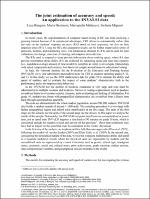Chapter The joint estimation of accuracy and speed: An application to the INVALSI data
Author(s)
Bungaro, Luca
Desimoni, Marta
MATTEUCCI, MARIAGIULIA
MIGNANI, STEFANIA
Language
EnglishAbstract
In Italy, the National Institute for the Evaluation of the Education and Training System (INVALSI) every year administers standardized tests via computer-based testing (CBT) to students attending grades 8, 10, and 13. The CBT mode allows to collect data not only on the students’ response accuracy (RA) based on item responses, but also on their response times (RT). By using these data, it is now possible to estimate the speed ability of examinees, besides the usual ability (e.g. Italian language, mathematics or English ability). In this study, we use the 2018 mathematics data for grade 10 to estimate the ability and speed of students following the fully Bayesian approach of Fox et al. (2021), who implemented in the R package LNIRT the models of van der Linden (2007) and Klein Entik et al. (2009). In a second step, we use the estimated mathematics ability and speed in a bivariate multilevel model, where the first-level units are represented by students and the second-level units are represented by classes. Covariates such as gender, school type, immigrant status, economic, social, and cultural status, prior achievement, grade retention, student anxiety, class compositional variables, and geographical area are included in the model. The main results show that the ability and speed are inversely proportional, e.g. as ability increases, speed decreases. Also, differences in the students performance by gender and school type are significant for both ability and speed.
Keywords
educational assessment; large standardized test; mathematics achievement; IRT models for response times; multilevel modelsDOI
10.36253/979-12-215-0106-3.39ISBN
9791221501063, 9791221501063Publication date and place
Florence, 2023Series
Proceedings e report, 134Classification
Society and Social Sciences


 Download
Download Web Shop
Web Shop